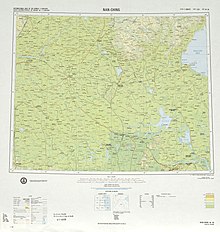Ting-yüan
Appearance
English
[edit]
Etymology
[edit]From Mandarin 定遠/定远 (Dìngyuǎn), Wade–Giles romanization: Ting⁴-yüan³.
Proper noun
[edit]Ting-yüan
- Alternative form of Dingyuan
- 1973, Yu-wen Jen, “Warfare in the Yangtze Valley (1856-1859)”, in The Taiping Revolutionary Movement[1], Yale University Press, →ISBN, →LCCN, →OCLC, pages 345, 613:
- During the summer, while Ch’en attacked Lai-an and Ch’u-chou, Wu left Lu-chou for an attack on Ting-yüan with the assistance of Nien chief Kung Te-shu.
- 1980, Elizabeth J. Perry, “Protectors Turn Rebels: The Case of the Red Spears”, in Rebels and Revolutionaries in North China, 1845-1945[2], Stanford, California: Stanford University Press, →ISBN, →OCLC, page 169:
- For example, in 1928, after a Red Spear force succeeded in routing bandits from Anhwei’s Hsü-i and Ting-yüan counties, the brigands regrouped in nearby Hsüchou.
- 1994 [145–86 BCE], Ssu-ma Chʻien, edited by William Nienhauser, The Grand Scribe's Records[3], volume 1, Indiana University Press, →ISBN, →LCCN, →OCLC, page 206:
- When he reached Yin-ling 陰陵,²⁶⁵ he lost his way and asked an old farmer.[...]
²⁶⁵ A county northwest of modern Ting-yüan 定遠 County in Anhwei (Wang Li-ch'i, 7:182n.) about 25 miles east of modern Huai-nan 淮南 City (see also T'an Ch'i-hsiang, 2:19).
- For more quotations using this term, see Citations:Ting-yüan.
Translations
[edit]Dingyuan — see Dingyuan
Further reading
[edit]- Leon E. Seltzer, editor (1952), “Tingyüan”, in The Columbia Lippincott Gazetteer of the World[4], Morningside Heights, NY: Columbia University Press, →OCLC, page 1916, column 2
Anagrams
[edit]Categories:
- English terms borrowed from Mandarin
- English terms derived from Mandarin
- English terms borrowed from Wade–Giles
- English terms derived from Wade–Giles
- English lemmas
- English proper nouns
- English uncountable nouns
- English multiword terms
- English terms spelled with Ü
- English terms spelled with ◌̈
- English terms with quotations
